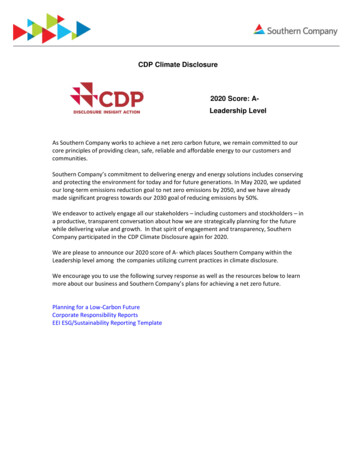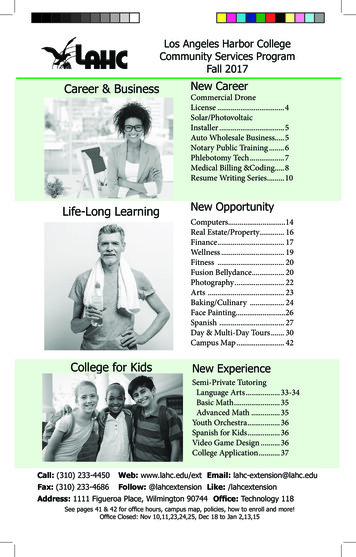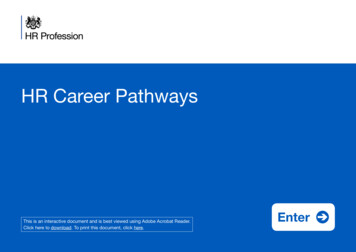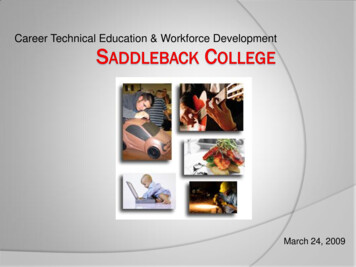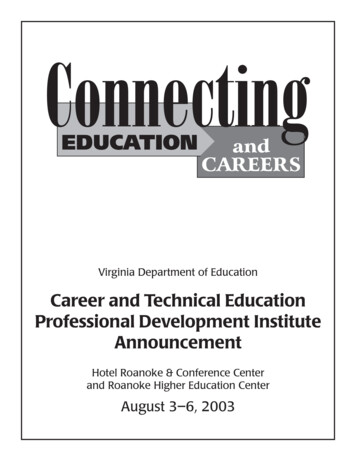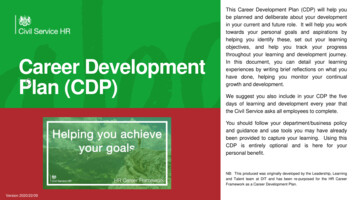
Transcription
Career DevelopmentCPlan (CDP)This Career Development Plan (CDP) will help yoube planned and deliberate about your developmentin your current and future role. It will help you worktowards your personal goals and aspirations byhelping you identify these, set out your learningobjectives, and help you track your progressthroughout your learning and development journey.In this document, you can detail your learningexperiences by writing brief reflections on what youhave done, helping you monitor your continualgrowth and development.We suggest you also include in your CDP the fivedays of learning and development every year thatthe Civil Service asks all employees to complete.You should follow your department/business policyand guidance and use tools you may have alreadybeen provided to capture your learning. Using thisCDP is entirely optional and is here for yourpersonal benefit.NB: This produced was originally developed by the Leadership, Learningand Talent team at DIT and has been re-purposed for the HR CareerFramework as a Career Development Plan.Version 2020/22/09
Using the Career Development Plan (CDP) This CDP has spaces for you to map your career pathway, write down your goals for the year and advice onmapping out your specific strengths and areas for improvement. Plan your learning quarter by quarter, and tailoreach quarter’s learning objectives to the opportunities that are available to you during that period. Whether you’re learning on the job, in an event, or in your own time, set some time aside to reflect on what you’velearned. Use the space provided in the progress tracker to note down your thoughts on your learning as you go. This CDP will not be assessed and is solely for your benefit. However, if you share this with your line manager,coach or mentor, it will be a useful means of providing feedback for them, so they can continue to help you to learnin ways that suit you. See Annex A and Annex B if you need help figuring out which behaviours and professional areas you need to focuson. Consult the HR Success Profiles Matrices and the CIPD Profession Map to self-assess and see how well youmeasure up against these. They detail the skills, behaviours and experience needed for anyone in the HRprofession and what behavioural indicators HR professionals should be demonstrating. Use Annex C to plot yourcareer path. If you have any questions about the learning opportunities available to you, talk to your line-manager – find outwhat’s on offer in your department. Also discuss your learning with your coach or mentor.
HR Career Development enericLearningJobFamilyspecificlearningWhether you want to become anexpert in what you know or learnsomething new, the HR CareerDevelopment Offer (CDO) is allabout you.Use your CDP to track your learningand development using theopportunities that the CDO givesyou.To find out more about the offer, referto the HR Career Framework.
Mapping your career pathwayIt’s the next step that matters: Focus on current role first What do I want from the role? What do I want my legacy to be? What am I really good at? What are mystrengths? How do I know? Feedback, 360 Easy and quick to do What sort of work do I want to do next? Shadowing Mentoring Secondments How will I get there? Career/Talent conversation What’s on offer? CDPCareer pathway isn’t necessarily aboutpromotion, it’s about taking a deliberate andplanned approach to what you do and howyou do it.Annex C: Career Pathway template
Starting offBefore you start writing your learning and development plan, it’s important to reflect on the skills and behaviors youhave and think about where you want to improve. Use this space to jot down how you feel about your current skillset.These are the topics, skills andbehaviours in which I want toimprove in the near future.These are the topics, skills andbehaviours in which I want toimprove in the long term.These are the areas and skills inwhich I am expert and confident.
My learning goalsWrite down your overall goals for your next year of career development.Try asking yourself the following: Where do you see yourself in a year’s time? Which areas do you most want to learnabout? In which skills and behaviours would you like to progress? Jot them down below.Year: 20 /20Goal 1Goal 2Goal 3
Progress trackerUse this space to make notes on how your learning and development is going over the year. It is recommended thatyou keep a detailed set of notes on what you have learned for future reference.Quarter 1 (April – June)Quarter 2 (July - Sept)Quarter 3 (Oct - Dec)Quarter 4 (Jan - Mar)
Mid-year reflectionFocus your reflection in this space on the most memorable and effective learning you have done in the last sixmonths. What made it so effective? How do you learn best? Think back to when you filled in your Starting Off table.How has your skillset changed in the last six months? What are your current learning and developmental priorities?Feed back your thoughts on this to your Job Family Lead.
End of year reflectionFor this reflection, consider the following questions:1.What skills have you learned in the last year and what behaviours did you improve upon?2.What ways of learning have been most useful for you?3.How much time have you put into your L&D, and if you break down those hours further, on what did you spend themost and least time?
Appendix A: Behaviours for HRThe HR Success Profiles are a powerful tool when considering your career path. They are a great way to help youassess your strengths and behaviours, and draw out your experiences and skills. Understanding these can help youshape your career path and keep your skills relevant for current and future roles.HR Success Profiles Matrices sets outthe technical skills, behaviours andexperience required in HR. Downloadthe Matrices to see how well youmeasure up against these.
Appendix B: The CIPD Profession MapCIPD’s Profession Map defines the building blocks of effective people management practice across ten professionalspecialisms and describes eight fundamental behaviours that underpin good practice regardless of specialism. It'salso flexible, so you can choose what to focus on depending on your area of work, the level of accountability you havein your role, and your career development ion-mapThe CIPD Profession Map is aninteractive tool. Why not give it a try!
Appendix C: Career Pathway templateHR Job FamilyCaseworkDiversity & InclusionHR Business PartneringHR OperationsLearning & TalentOrganisational Design & DevelopmentPolicy & Employee RelationsRewardStrategic Workforce PlanningLevel 1 (AO/EO)Level 2 (HEO/SEO)Level 3 (G6/G7)Level 4 (Deputy Director/ Director)
Career Development Plan (CDP)C This Career Development Plan (CDP) will help you be planned and deliberate about your development in your current and future role.
